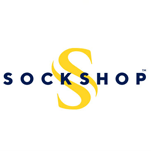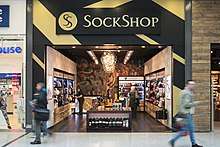Sock Shop
SOCKSHOP is a British-based specialist retailer of socks and hosiery. Founded in 1983 by Sophie Mirman and Richard P. Ross, SOCKSHOP became part of the Ruia Group in 2006, and is now based mainly online, with stores in the Manchester Arndale and The Lowry Outlet, as well as concessions across the United Kingdom.
 | |
| Industry | Retail Specialist |
|---|---|
| Founded | 1983 |
| Headquarters | Bolton, Greater Manchester , |
| Products | Socks Hosiery Tights Underwear Accessories |
| Parent | Ruia Group |
| Website | www |
Concept
Mirman said "People should be able to buy socks and stockings as easily as they buy newspapers".[1] She envisioned small shops that only sold women's tights, stockings, and socks. With this in mind, SockShop outlets were placed for convenience on busy city streets, in train stations, subway stations and at airports. They were small, between 400 and 1,200 square feet (110 m2), and had no visible doors, which drew passers-by (as many as 1000 a day) into the store.[1] Their stock featured bold colours, dramatic patterns and novelty designs in hundreds of styles. Prices were considered moderate at £0.99 to £24.99 per pair in 1987, with the priciest designs including gold-lace tights.[1]
Founders
Sophie Mirman is the daughter of the milliner Simone Mirman. She started out as a junior secretary at Marks & Spencer before applying for the company's management training program. She then became a manager for the Marks & Spencer food department. In 1981, Mirman and her future husband Richard P. Ross became retail directors for a new speciality retailer, Tie Rack, which sold neckwear and accessories for men. They left in 1983 to launch SockShop .[1]
Business history
Early years
Mirman identified there was a need to buy stylish hosiery without hunting through large department stores, which at the time, dominated the British hosiery market.[1] With the assistance of a Government loan guarantee programme for capital-short entrepreneurs, Mirman and Ross eventually launched SockShop in 1983. The first SockShop store was opened on the concourse of the Knightsbridge tube station. At that time, their ambitions were modest, with expectations of eventually having four or perhaps six retail outlets.[1] However, by 1987, there were 52 stores in the Sock Shop chain and it became one of the fastest growing specialty retailing businesses in Europe.[1] Mirman had become the 188th richest person in Britain, and its youngest millionaire.[2] They were held up as examples of Britain's new entrepreneurial flair in the 1980s.[1]
In November 1987, SockShop (recently renamed as a company to Sock Shop International P.L.C) opened three stores in Manhattan, aiming (as in London) towards walk-by traffic. One of these outlets was at the 42nd Street entrance to Grand Central Station, the same principle as behind the first British store's placement.
Administration
A couple of years later, when recession struck, Mirman and Ross discovered that their equity (worth £50 million in 1988) had become valueless, and they were overwhelmed by debts.[2] In 1990, they entered administration and BDO Binder Hamlyn took over. 58 shops, including 17 US outlets (14 in New York alone) were closed down, and discussions were entered with interested parties to try to get new funding capital for financing expansion in Europe.[3] Despite the closures, the administrators recommended Mirman be retained in a key role, praising her business acumen.[4]
In August 1990 the business, 85 shops, and the French subsidiary were purchased for £3.25 million (plus an injection of £3.75 million working capital) by a consortium backed by a Scottish fund manager, Murray Johnstone. The company was renamed SockShop Holdings. Unsecured creditors and shareholders in SockShop International received no money from the sale. The chairman for Murray Johnstone Developments, Fred Dalgarno, blamed the expense of the US operation and over-expansion for Sock Shop's problems. Having shed the burden of their debts, it was planned that SockShop Holdings be expanded more cautiously.[5]
SockShop Holdings fell back into the administrator's hands a second time after becoming part of the Facia Group, a retail conglomerate of 850 shops and 80,000 employees that collapsed in 1996 with debts of £70m due to the fraudulent actions of its owner, Stephen Hinchliffe.[6] It was subsequently acquired by the Tulchan Group.
In 2003, SockShop (by then reduced to 13 stores across the UK) was bought for £3.9 million by the Birmingham-based firm of Harris Watson Holdings. The firm collapsed a third time in 2006. The administrators, Poppleton & Appleby, were brought in on 25 January 2006 to try and salvage the dramatically reduced company. This third collapse was attributed to substantial losses as a result of a slowdown in consumer spending and a rise in running costs.[7] In February 2006 following administration it was bought by Osan Ltd which is a subsidiary of Ruia Group.
Ruia Group (2006-present)
Following the 2006 purchase, SOCKSHOP has become primarily an internet retailer, and is based at Dove Mill in Bolton.
Online Shop
The online store, www.sockshop.co.uk, houses SOCKSHOP's largest collection which includes socks, tights, hosiery, underwear and accessories from more than 90 brands - among them Falke, Pantherella, Calvin Klein, Sloggi, Happy Socks and Stance, as well as several of their own brands including Pringle, ELLE, Heat Holders, Glenmuir, Jeep, Workforce and Wild Feet. SOCKSHOP.co.uk boasts a wide and growing range of bamboo products, including socks and underwear.
Stores
SOCKSHOP has 2 main stores, as well as a number of concessions across the UK.

The Lowry Outlet
SOCKSHOP opened a store in The Lowry Outlet in 2014, selling a selection of socks from the company's own brands, as well as items from other companies within the Ruia Group.
Manchester Arndale[8]
In 2015, SOCKSHOP opened a store in the Manchester Arndale shopping centre in Manchester city centre. Located on the ground floor of the centre, the store sells a range of products from SOCKSHOP's own brands.
Charity Work
Socks for a Cause
In 2018, SOCKSHOP launched its Socks For A Cause[9] campaign, donating 20,000 pairs of socks to various homeless charities[10] in an effort to combat the growing problem of trenchfoot among the homeless, and to help tackle the homelessness problem in Greater Manchester. SOCKSHOP continues to donate socks, underwear and accessories to homeless charities across the country.
Pride Socks
SOCKSHOP designed and launched a range of Pride socks in 2017, donating 20% from the sale of each pair sold to the LGBT Foundation - a Manchester-based charity which provides help and support for members of the LGBT+ community.
References
- Lohr, Steve, A "Silly" Sock Idea Makes Millions, for The New York Times, November 23, 1987
- O'Sullivan, Jack, Going to the dogs (and other ways to survive a recession), for The Independent, August 21, 1998
- Butler, Sarah, Sock Shop Looks for New Capital in Drapers, January 20, 1990
- Sophie Mirman May Play Key Role In Sock Shop Rescue Package, Drapers, June 2, 1990
- Butler, Sarah, Sock Shop's Future Plans Revealed Following Consortium Acquisition in Drapers, August 11, 1990
- Tycoon jailed after "lenient" sentence BBC News Online, 16 July 2003
- Butler, Sarah, Buyer sought for Sock Shop as it collapses for third time in The Times January 26, 2006
- Greer, Stuart (2018-08-22). "Fashion retailer SockShop enjoys a 31 per cent sales boost". men. Retrieved 2019-06-06.
- "Donated socks used to fight trench foot in homeless people". ITV News. Retrieved 2019-06-06.
- "No mean feet – Manchester charities receive a year's supply of socks". The Big Issue. 2018-02-06. Retrieved 2019-06-06.